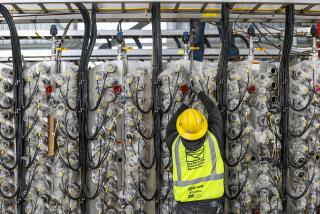Power Plant for 6 Cities Is Launched
- Share via
Seeking to get the most out of their energy supplies, officials from six Southern California cities broke ground Tuesday for a $234-million power plant in Burbank as part of a joint power-sharing arrangement.
Operated by Burbank Water and Power, the natural-gas-fueled plant will provide electricity for at least 240,000 homes in Anaheim, Cerritos, Colton, Glendale and Pasadena as well as Burbank, officials said.
Construction of the Magnolia Power Plant, being built near Burbank’s existing power plant, is expected to be completed in 2005, officials said.
The plant will be owned jointly by the six municipalities under the auspices of the 11-member Southern California Public Power Authority based in Pasadena, officials said. The cities agreed to pay the planning, construction and operational costs in exchange for a percentage of the power the plant generates.
“By joining together, these six cities will provide consumers with
Plans to build a new power plant had been discussed by Burbank city officials for several years. However, the state’s power crisis in the summer of 2001 and its streamlined review process for power-plant construction rekindled interest in a jointly owned and operated generator fueled by natural gas.
“For these cities, Magnolia Power Plant will increase local control and reliability over their electricity supply,” Davis said. “Each city will be able to reduce its utilization of power resources in other Western states.”
Electricity from the new plant will supplement the power each city generates on its own.
All six city councils voted to enter into a planning agreement with the power authority to build the generator, officials said. The California Energy Commission approved the plant’s license application in March.
“This will give us clean, reliable power right here in Burbank when we need it,” especially during natural disasters and other emergencies, said Fred Fletcher, assistant manager of the city’s water and power department.
By jointly building and operating a larger plant than any of the cities could have done on its own, each is able to offer consumers competitive rates -- about 4 cents to 5 cents per kilowatt-hour, said Mike Ebbing, a spokesman for Anaheim Public Utilities. “With six cities combining their resources, it will result in a lower lifetime fuel consumption, a higher efficiency rating and lower air emissions,” he said.
“That will lead to lower overall operating costs for all of the cities.”
More to Read
Sign up for Essential California
The most important California stories and recommendations in your inbox every morning.
You may occasionally receive promotional content from the Los Angeles Times.













